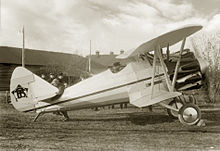Polikarpov I-5
| Polikarpov I-5 | |
|---|---|

|
|
| Type: | Fighter plane |
| Design country: | |
| Manufacturer: | |
| First flight: |
April 29, 1930 |
| Commissioning: |
1930 |
| Production time: |
1930-1934 |
| Number of pieces: |
803 |
The one -and-a-half-decker Polikarpow I-5 ( Russian Поликарпов И-5 , also Grigorowitsch I-5 ) was built in the early 1930s and was the standard fighter of the Soviet air force until 1936 . Up to 1934, 803 copies were made, including the prototypes.
development
In December 1929, a small working group was set up with the two designers Nikolai Polikarpow and Dmitri Grigorowitsch , who had just been arrested, for the development . The work was carried out under guard at aircraft plant No. 39. Construction progressed rapidly so that the first WT-11 prototype was able to take off on its maiden flight on April 29, 1930 with test pilot B. L. Buchholz. It was powered by a French Gnôme-Rhône Jupiter VII engine. The abbreviation WT stands for Wnutrennaja Tjurma (Вңутренная тюрьма, internal prison) and refers to the conditions under which the aircraft was built.
Two prototypes followed, the Klim Voroshilov ( Russian Клим Ворошилов ) with a Jupiter VI - and the Podarok XVI. Partsjesd (Подарок XVI. Партсъезд, present for the 16th party congress) with a local M-15 engine. Number 3 first flew on July 1, 1930 and had a Townend ring fitted to provide better air cooling.
The first seven series machines were produced in August / September 1930 at Plant No. 21 and were equipped with a more powerful M-22 engine, which was also retained. The air force received the I-5 in 1933 and flew it for almost nine years, even if at the end only as a training machine. Thanks to its good-natured flight characteristics, it was possible for the first time in the Soviet Union to research flat spin by the pilot W. A. Stepantschonok .
In 1934 a two-seater school version appeared, but it was only built twice. A small number of I-5s were equipped with four 7.62mm MG PW-1s with a total of 2000 rounds of ammunition instead of two . The Soviet Black Sea Fleet was still using some I-5LSch ( LSch, Russian for light attack aircraft ) aircraft in 1940 . The I-5 was also used when the Sweno projects were tested .
technical description
The I-5 was a composite construction . The fuselage consisted of a welded tubular steel construction, which was planked with metal at the front and covered with fabric at the rear. The wings consisted of a wooden frame, the tail unit of a light metal frame. The entire structure was braced and also covered with fabric. The chassis was rigid and had a continuous axle with a tail spur.
Technical specifications
| Parameter | Data |
|---|---|
| crew | 1 |
| span | above 10.24 m below 7.44 m |
| length | 6.78 m |
| height | 2.03 m |
| Wing area | 21.25 m² |
| Wing loading | 63.7 kg / m² |
| Power load | 2.8 kg / hp |
| Preparation mass | 943 kg |
| Takeoff mass | 1355 kg |
| drive | an air-cooled radial engine M-22 |
| power | 348 kW (473 hp) |
| Top speed | 286 km / h near the ground (with wheeled chassis) 278 km / h near the ground (with ski chassis) 252 km / h at an altitude of 5,000 m |
| Landing speed | 95 km / h |
| Rise time | 1.6 min at 1000 m altitude 5.6 min at 3000 m altitude 10.1 min at 5000 m altitude |
| Summit height | 7300 m |
| Flight duration | 2.5 h |
| Range | 660 km |
| Flight duration | 2.0 h |
| Duration of a full curve | 16 s |
| Takeoff route | 100 m |
| Landing route | 200 m |
| Armament | two 7.62 mm MG PW-1 with 1200 rounds each and two 10 kg bombs |
literature
- Wilfried Copenhagen : Soviet fighters . Transpress, Berlin 1985 (VLN 162-925 / 145/85).

